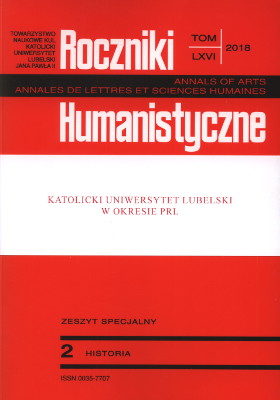Młodzież studencka Katolickiego Uniwersytetu Lubelskiego i jej życie codzienne
Students of the Catholic University of Lublin and Their Everyday Life
Author(s): Marek WierzbickiSubject(s): History, Recent History (1900 till today), WW II and following years (1940 - 1949), Post-War period (1950 - 1989)
Published by: Towarzystwo Naukowe KUL & Katolicki Uniwersytet Lubelski Jana Pawła II
Keywords: students; the Catholic University of Lublin; communism; everyday life
Summary/Abstract: The paper describes the problematics of development, evolution and attitudes of students of the Catholic University of Lublin (KUL) in the period of the so called People’s Poland (1944-1989). It aims to analyze the situation of theirs during the communist dictatorship when its leaders tried to subjugate or even liquidate this catholic university due its being independent of them. Therefore, one should realize the policies of the communist state influenced the plight of the students of KUL considerably. For example, during the Stalinist period (1948-1955), apart from individual repressions, some faculties and courses were closed down, the number of students was reduced drastically as well as the prospects for scientific advancement of the scholars who were employed there. During the whole discussed period the students were discriminated against. It was carried out by limiting their access to decent accommodation, health care, scholarships and premises. They also had much smaller job opportunities than their colleagues from state-owned universities. On the other hand, they experienced much greater intellectual freedom than the rest of the Polish students which was caused by the limited influence of the communist ideology and censorship. As a result, they could enjoy contacts with intellectual output of the Western civilization. As a collectivity, the students of KUL showed visible specificity in the ideological field, e. g. they were involved in opposition activity much more often than the students from state-owned universities. They also supported the moral teaching of the Catholic Church much more willingly. To a certain degree the student community of KUL were similar to their counterparts across Poland. Among other things, from the middle of the 1960-ies the proportion of candidates from among the intelligentsia and women as well as youth from the Lublin region rose among the students of KUL which reflected the nation-wide tendencies. Their situation changed for the better towards the end of the communist era in Poland when the communist leadership had to seek support from the Catholic Church.
Journal: Roczniki Humanistyczne
- Issue Year: 66/2018
- Issue No: 2S
- Page Range: 403-437
- Page Count: 35
- Language: Polish

